Energy Storage White Papers and Reports
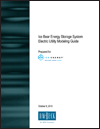
Energy Storage Modeling Guide for Utilities
R.W. Beck - February 2011
Developed by R.W. Beck for Ice Energy, this 63-page guide is designed to assist utility planners and analysts in determining how to account for energy storage-equipped facilities as part of a utility's electric system analysis and planning processes.
Download (1.2 MB pdf file)
Energy Storage: A Cheaper, Faster & Cleaner Alternative to Conventional Frequency Regulation
California Energy Storage Alliance - January 2011
To illustrate the value of energy storage in the ancillary services frequency regulation market, this paper examines a specific ancillary service -- frequency regulation -- and compares the performance of a flywheel kinetic energy storage device with a conventional baseload combined cycle combustion turbine. This paper also looks at how other energy storage technologies can provide frequency regulation, and includes examples of existing and developing projects.
Download (2 MB pdf file)
Integrating Renewable Electricity on the Grid
American Physicists Society – November 2010
Renewable resources present a new set of technological challenges not previously faced by the grid: the location of these resources far from population centers, and the variability of renewable generation. Although small penetrations of renewable generation on the grid can be smoothly integrated, accommodating more than approximately 30% electricity generation from these renewable sources will require new approaches to extending and operating the grid, including Energy Storage.
Download (6 MB pdf file)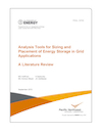
Analysis Tools for Sizing and Placement of Energy Storage in Grid Applications
DOE - September 2010
This report, prepared for the U.S. Department of Energy by Pacific Northwest National Laboratory, reviews and evaluates available literature and studies to identify the current state-of-the-art models and analytical tools that optimize the siting, sizing and economic value of energy storage in a smart grid infrastructure.
Download (3 MB pdf file)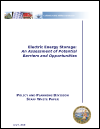
Electric Energy Storage – Assessment of Barriers and Opportunities
California Public Utility Commission - July 2010
California policymakers support the development of EES because it can provide an advantageous strategy for meeting the state’s long-term clean energy goals while maintaining system reliability. However, relatively little information about EES costs and benefits is available to form a rational basis for policy action. The purpose of this paper is to identify for policymakers the opportunities for and barriers to the development and deployment of EES technologies throughout California’s electricity system.
Download (530 KB pdf file)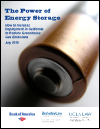
The Power of Energy Storage: How to Increase Deployment in California to Reduce Greenhouse Gas Emissions
Sunshine and wind, even in California, are intermittent resources, while the state’s energy needs run twenty-fours hours of every day. As California seeks to expand solar and wind power, storage of that energy for use at any time, day or night, becomes critical.
Download (4 MB pdf file)Energy Storage: A Cheaper and Cleaner Alternative to Gas-Fired Peakers
California Energy Storage Alliance - June 2010
This paper examines the cost effectiveness of energy storage as an alternative to natural gas-fired peakers, by performing a detailed analysis comparing the cost of a kilowatt-hour (kWh) of electricity generated on-peak by a gas-fired peaker, with the cost of a kWh of electricity provided on-peak by an energy storage system.
Download (1 MB pdf file)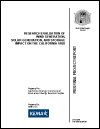
Research Evaluation of Wind Generation, Solar Generation, & Storage Impact on the California Grid
California Energy Commission - June 2010
This report analyzes the effect of increasing renewable energy generation on California’s electricity system and assesses and quantifies the systemʹs ability to keep generation and energy consumption (load) in balance under different renewable generation scenarios. In particular, researchers assessed four key elements necessary for integrating large amounts of renewable generation on California’s power system. Researchers concluded that accommodating 33 percent renewables generation by 2020 will require major alterations to system operations. They also noted that California may need between 3,000 to 5,000 or more megawatts (MW) of conventional (fossil‐fuel‐powered or hydroelectric) generation to meet load and planning reserve margin requirements.
Download (2 MB pdf file)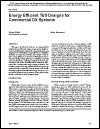
ASHRAE: Energy Efficient TES Designs for Commercial DX Systems
ASHRAE - May 2010
This paper describes the basis for an energy efficient refrigerant-based thermal energy storage system design for commercial DX systems. A description of a system is given, and design aspects contributing to energy efficiency are identified. Similarly, operating characteristics and strategies contributing to energy efficiency are discussed. Challenges in measuring and predicting energy efficiency are identified, along with a proposed method for collecting certified performance data, and sample test results. Field data is then analyzed to determine if it is consistent with energy savings predictions. The benefits of using such energy efficient thermal energy storage systems are then considered for several climate zones. Results show that refrigerant-based thermal energy storage for commercial DX systems is energy neutral or better given specific design considerations and operating strategy.
Download (1 MB pdf file)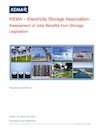
Assessment of Jobs Benefits from Energy Storage
KEMA Inc. for the Electricity Storage Association - March 2010
This report examines job creation estimates associated with potential energy storage legislation. The analysis quantified the market size of key energy storage application areas and created an energy storage penetration model to examine the yearly megawatt (MW) market size based on the economic payback period and assessed how proposed incentives would increase market penetration. Incremental job creation was estimated based on increased market penetration and associated sales revenue generated by the incentives.
Download (476 KB pdf file)



